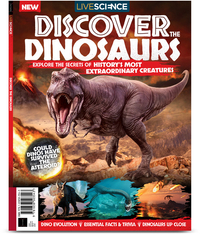4-year-old discovers impressive dinosaur footprint on Wales beach
The track shows the impression of the dino's footpads and claws.

A 4-year-old girl walking on a beach with her family in Wales has discovered the best-preserved dinosaur track from the area.
The track is from a beach known for footprints from crocodilians, extinct ancestors of modern crocodiles. The dinosaur that made the print probably stood 30 inches (75 centimeters) tall and 8.2 feet (2.5 meters) long. Its 4-inch (10 cm) track looks similar to that of the dinosaur Coelophysis, though that particular species lived in North America, not what is now Europe.
Lily Wilder, a preschooler on a stroll with her father at Bendricks Bay, discovered the track.
Related: Photos: Dinosaur tracks reveal Australia's 'Jurassic Park'
Discover the Dinosaurs: $22.99 at Magazines Direct
Journey back to the age of dinosaurs with Live Science and uncover the secrets of some of the prehistoric world’s most remarkable beasts. From the Tyrannosaurus rex and Diplodocus to the Triceratops and Coelophysis, get up close and discover how these fascinating creatures lived, hunted, evolved and ultimately died out. Why did Stegosaurus travel in herds? Is it possible to clone a dinosaur? Find the answers to these questions and many more.
"It was Lily and Richard (her father) who discovered the footprint," Lily's mother Sally Wilder said in a statement. "Lily saw it as they were walking along, and said 'Daddy look.' When Richard came home and showed me the photograph, I thought it looked amazing. Richard thought it was too good to be true. I was put in touch with experts who took it from there."
The print was on a loose rock and has now been removed to National Museum Wales (Amgueddfa Cymru in Welsh) with permission from Natural Resources Wales, the government-sponsored body that regulates conservation and environmental issues.
"This fossilized dinosaur footprint from 220 million years ago is one of the best-preserved examples from anywhere in the U.K. and will really aid palaeontologists to get a better idea about how these early dinosaurs walked," Cindy Howells, the paleontology curator at the museum, said in the statement.
Sign up for the Live Science daily newsletter now
Get the world’s most fascinating discoveries delivered straight to your inbox.
The fossil is so detailed that the claws and pads of the feet are visible. The print is a type known as a grallator, meaning a bipedal theropod dinosaur with three toes created it. The dinosaur lived at the beginning of the Triassic period, when the region was a desert dotted with occasional saline lakes. Dinosaurs had evolved only about 10 million years before this mysterious three-toed creature walked this landscape, so its print is a tantalizing clue into early dinosaur history, according to National Museum Wales.
"During the COVID pandemic, scientists from Amgueddfa Cymru have been highlighting the importance of nature on people's doorstep, and this is a perfect example of this," Howells said. "Obviously, we don't all have dinosaur footprints on our doorstep, but there is a wealth of nature local to you if you take the time to really look close enough."
Originally published on Live Science.

Stephanie Pappas is a contributing writer for Live Science, covering topics ranging from geoscience to archaeology to the human brain and behavior. She was previously a senior writer for Live Science but is now a freelancer based in Denver, Colorado, and regularly contributes to Scientific American and The Monitor, the monthly magazine of the American Psychological Association. Stephanie received a bachelor's degree in psychology from the University of South Carolina and a graduate certificate in science communication from the University of California, Santa Cruz.










